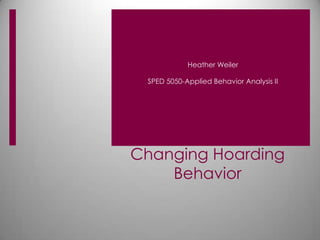Behavior Change Study
- 1. Heather Weiler SPED 5050-Applied Behavior Analysis II Changing Hoarding Behavior
- 2. Abstract This study was designed to determine an effective teaching strategy to decrease hoarding behavior for students with severe disabilities. The target behavior, hoarding, is defined as bringing an excessive amount of nonessential items to school which were never used. A multiple baseline design was used to determine if the teaching strategy selected would change the hoarding as well as arrival punctuality. The teaching strategy selected is based on the cognitive linguistic research of Paul Bloom, Dan Slobin, and Melissa Bowerman. The specific research was from the intervention study for categorization acquisition by Partyka and Krescheck (1983) By teaching meaning of words within a positive communicative context, the student will gain organization and comfort to facilitate transition across physical settings. The results indicated the intervention decreased the hoarding but had no effect on arrival time.
- 3. Subject âĒ17 year old high school student with severe deficits in cognitive and language âĒ5 year history of hoarding for food and nonfood items âĒWhen limits are set student becomes aggressive âĒSleep cycles are inconsistent. When not sleeping at night, foraging for items occurs âĒSchool Arrival time late over 90% of days âĒMost problematic early morning and late night and transitioning physical settings
- 4. Functional Assessment Interview Results âĒFunctional Assessment Interview Form OâNeil et al âĒHigh Priority Problematic Behavior Hoarding Items âĒPredictors âĒTime of Day âĒMoving from on Location to another âĒFree Time âĒUnsupervised Time âĒImmediate Antecedents âĒLeaving house âĒChange in schedule âĒMaintaining Consequences âĒdelays transition âĒobtains home based items âĒavoids loss of personal possessions âĒReinforcer Toys CDs âĒFood
- 5. Hypothesis The target behavior of hoarding increases when there is a change in structure 1. Physical setting 2. Low to No Structure Activity It is hypothesized that the hoarding behavior functions to bring meaning and a comforting structure to the situation An effective replacement or competing behavior would be bringing those objects related to the immediate context.
- 6. Research Design Selection Multiple Baseline 1. Items brought to School 2. School related objects 3. School Unrelated Objects 4. Arrival Punctuality The project looked at these variables to determine the relationship change between objects and punctuality following a behavioral teaching intervention
- 7. Intervention Strategy Procedure âĒUpon classroom entry, teacher engages using a positive and enthusiastic attitude. âĒStudent is given a box with name on it. âĒStudent is instructed to name each item and place it in the box as teacher records them on a list âĒAs each item is named, the teacher provides two attributes for the item. One includes its use (function) within the educational setting. âĒThe teacher asks, âDo you need this for school?â âĒStudent responds âyes/noâ or by nod âĒTeacher then summarizes every item aloud from the list and notes ones that are not school related and then those that are. âĒStudent puts the box in a cubby within eyesight.
- 8. Research Basis âĒPaul Bloom (2000) âĒHow Children Learn the Meaning of Words âĒMelissa Bowerman (2001) âĒShaping the Meaning for Language âĒPartyka and Krescheck (1983) âĒA Comparison of Categorization Skills of Normal and Language âDelayed Children in School âĒDan L. Slobin (2001) âĒForm- function relationships: how do children find out what they are?
- 9. Data Collection Procedure âĒData taken daily upon arrival âĒData was a listing of all items brought âĒDate recorded for arrival time âĒData taken for 32 days
- 10. Results Baseline: âĒ Number of Objects ranged from 22 â 25 âĒAll objects were nonrelated to school âĒStudent never initiated any interaction with objects during school day Intervention Phase: âĒDecrease in Objects first presentation of procedure resulted in a decrease from 24 objects to 8 âĒIncrease in School Related Objects 0% to 95%
- 11. Replacement Behavior Change Changes in Transitional Objects for Attending School 30 25 20 Number of Objects Daily 15 Unrelated Objects School Related Objects 10 5 0 Dates
- 12. Behavior Trends Table 1
- 13. Number of Objects 10 15 20 30 25 0 5 -5 1/26/09 1/28/09 1/30/09 2/1/09 2/3/09 2/5/09 2/7/09 2/9/09 2/11/09 2/13/09 dates 2/15/09 2/17/09 2/19/09 2/21/09 2/23/09 2/25/09 2/27/09 Trends in Object Types 3/1/09 3/3/09 3/5/09 3/7/09 3/9/09 3/11/09 # of Objects 3/13/09 Unrelated Objects 3/15/09 Linear (# of Objects) School Related Objects 3/17/09 Linear (Unrelated Objects) 3/19/09 Linear (School Related Objects)
- 14. Number of minutes late 100 120 20 40 80 60 0 1/26/09 1/28/09 1/30/09 2/1/09 2/3/09 2/5/09 2/7/09 2/9/09 2/11/09 2/13/09 2/15/09 2/17/09 2/19/09 2/21/09 Dates 2/23/09 2/25/09 2/27/09 3/1/09 Punctuality 3/3/09 3/5/09 3/7/09 3/9/09 3/11/09 Relationship of Objects to Arrival Relationship between Arrival Time and Objects Brought 3/13/09 3/15/09 3/17/09 3/19/09 late Linear (late) # of Objects Linear (# of Objects)
- 15. Results Relationship Changes 1. Overall Number of Items Decreased 2. Inverse Relationship for Related to Unrelated Items As School Related Items Increased Unrelated Objects Decreased 3. No relationship change resulted for Arrival Time and Objects Brought
- 16. Implications âĒ The teaching intervention was effective in changing the problematic behavior to the targeted replacement behavior âĒAnother analysis to determine another strategy for changing the punctuality needs to be completed âĒUse of positive reinforcement in combination with a cognitive linguistic intervention technique should be explored for other students with cognitive and language limitations who display âhoardingâ behavior or âdelayingâ behaviors during transition âĒFurther study into the excessive collection of items to determine whether there is a difference between the DSM IV diagnosis of hoarding and those who collect items due to a lack of organization for relevancy due to limited cognitive and linguistic reasoning strategies âĒFurther study into hoarding (DSM IV) versus transitional object use in adolescence and students with significant disabilities
















